We often think of games as entertainment we enjoy on our phones, consoles, or in our free time. But gamification is no longer just about literal play. It’s showing up everywhere: classrooms, corporate training sessions, webinars, and even everyday presentations.
In fact, some of the most effective gamified learning platforms aren’t trying to look like games at all. They’re just really good at keeping people engaged while they learn.
Gamification works because it taps into what naturally motivates us. And a huge chunk of that is on competitive progress, and a bit of fun along the way. That’s why gamified learning makes such a huge difference.
Now, there are plenty of tools out there promising better engagement. But not all of them truly integrate gamification in a way that’s effective. That’s why we’ve done the work for you. Below is a handpicked list of real, tested gamified learning platforms, each one bringing something unique to the table when it comes to turning passive listeners into active learners.
| Gamified Learning Platform | Great for | Summary of key features | Pricing |
|---|---|---|---|
| ClassPoint | K–12 and higher-ed teachers using PowerPoint | Live quizzes in PowerPoint, gamified stars & badges, AI quiz generator, leaderboard, analytics | Free basic tier; Pro at $8/month |
| Edcafe AI | Teachers needing AI content creation and auto-grading | Auto scoring, feedback, chatbot tutors, AI slide/quiz/lesson generation, student analytics | Free Starter; Pro at $7.99/mo; Premium $14.99/mo |
| Quizlet | Upper elementary to college students and teachers | Digital flashcards, adaptive modes, team games (Quizlet Live), streaks, progress tracking | Free basic; Plus for teachers at $35/year |
| Blooket | Elementary/middle school classroom game-based reviews | Multiple game modes, leaderboards, power-ups, self-paced homework games | Free basic; Plus at $2.99/mo; Plus Flex $4.99/mo |
| Gimkit | Strategy-based quiz games in middle/high school | Live games, virtual currency, power-ups, assignments, detailed reports | Free basic; Pro at $59.88/year |
| Duolingo | All-ages language learners on mobile/desktop | XP, streaks, skill levels, leagues, gamified practice with hearts and badges | Free with ads; Super Duolingo at $6.99/mo |
| SC Training (formerly EdApp) | Corporate trainers using microlearning on mobile | Game-based templates, push reminders, leaderboards, spaced repetition, analytics | Free for small teams; Premium from $2.95/user/mo |
| ProProfs | Teachers and trainers creating quizzes and games | Quiz builder, game templates, badges, learning paths, certificates | Free basic; paid from $20/month |
| Mambo.IO | Corporate training with custom gamification layers | Custom points, badges, quests, levels, leaderboard, API integrations | Custom enterprise pricing |
| Centrical (formerly GamEffective) | Enterprise training and performance engagement | Story missions, coins, leaderboards, social learning, personalized goals | Enterprise pricing on request |
| Docebo | Medium/large businesses needing LMS with gamification | Points, badges, levels, contests, AI content, reward marketplace | Enterprise pricing on request |
| Moodle | Schools using open-source LMS with gamified plugins | Badges, XP, quests via plugins, leaderboards, arcade-style quiz games | Free self-hosted; MoodleCloud starts at ~$120/year |
1. ClassPoint – Best for teachers using PowerPoint in class
Great for: K–12 and higher-ed educators seeking live classroom engagement through quizzes and rewards.
If you’re a teacher who uses PowerPoint, (and honestly, who isn’t?) ClassPoint might just be the tool that changes how you interact with your students. It’s a gamified learning platform built right into the slides teachers already use.
ClassPoint includes game-style features like stars, badges, and leaderboards. Students earn points for correct answers and can see how they stack up against classmates, which adds a bit of friendly competition without getting off track.
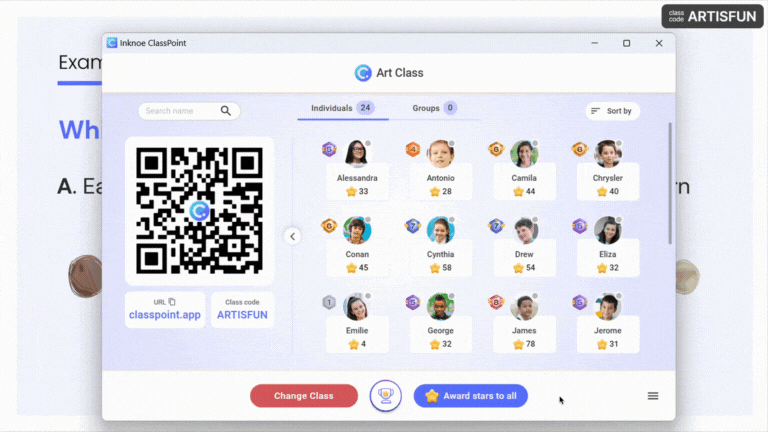
And if you’re running short on prep time (which, let’s be real, teachers often do), ClassPoint’s built-in AI can generate quiz questions from slide content automatically.
A huge plus is it works as a simple plugin for PowerPoint, so there’s no need to download extra apps or switch between programs. Teachers love how smoothly it fits into their existing workflow. The gamification is baked right in but never feels forced.
All student responses are saved after class, giving you clear insights to help shape your next lesson. With handy extras like drawing tools, whiteboard slides, and timers included, ClassPoint really transforms PowerPoint into a dynamic, and game-enhanced learning space.
Unsure where or how to start? Here's a quick guide on Creating A Lesson With ClassPoint From Start To Finish.
Key Features:
- Seamless PowerPoint Integration: Add live quizzes (MCQs, short answers, polls, etc.) into slides to collect real-time responses.
- Gamification Elements: Students earn stars for correct answers and participation, unlocking badges and climbing a live leaderboard for a fun competitive vibe.
- AI Quiz Generator: Automatically generate quiz questions from your slide content using AI to save prep time.
- Interactive Tools: Includes a random name picker, timers, and drawing tools to increase engagement without leaving PowerPoint.
- Analytics & Reports: Track responses instantly and review class results with downloadable reports for insight into student learning.
Pricing: Basic plan is free for up to 25 students per class (with limited questions and basic gamification). The Pro plan costs around $8/month per teacher (billed annually) and unlocks larger class sizes, unlimited quiz questions, advanced gamification, and AI features. There’s also a custom Premium plan for schools/districts with further expansions.
2. Edcafe AI – Best for AI-powered content creation and auto-grading
Great for: Middle school to university educators (and busy teachers of all grades) who want to generate materials and assessments with instant AI feedback.
Edcafe AI is a cutting-edge teacher’s assistant that uses artificial intelligence to create interactive learning content. And “interactive” is the key word here. It goes beyond basic AI content generation by turning static material into experiences that students can engage with in real time. But what makes it feel gamified is not attached on flashy badges or points, but rather, in the way students interact with the material through live, responsive activities.
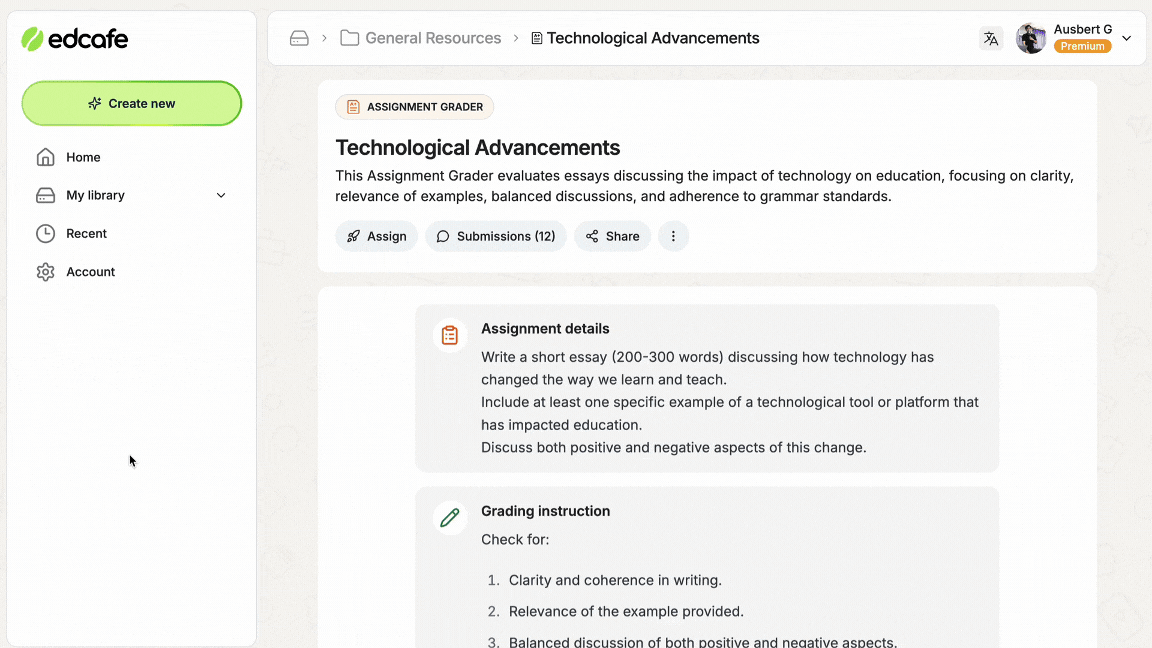
One standout feature is the auto-scoring system with personalized feedback. When students complete any AI-generated assessment done thru Edcafe AI, they get immediate grading and explainers why they got something right or wrong. This mimics game-like progression: learners try, fail, adjust, and improve in real time.
It also supports 24/7 chatbots that act as AI tutors, guiding students through tricky concepts and offering help when they’re stuck. These bots keep the learning process flowing, much like hints or guides in a game.
Key Features:
- Auto Scoring & Feedback: Edcafe AI assessments provide immediate scores and personalized feedback on student submissions, following your rubric to the letter.
- Interactive AI Tutors: Create custom chatbots that students can ask questions to; they’ll receive hints and answers as if an assistant were guiding them.
- Content Generation: Quickly produce lesson plans, slide presentations, flashcards, and even images or reading passages tailored to existing resources using AI.
- Analytics & Tracking: Collect student response data and get insight reports to gauge understanding and tailor your teaching.
Pricing: Edcafe AI offers a Free Starter tier for basic use (up to 100 AI credits/month and a few auto-graders) The Pro plan is $7.99/month per teacher (billed annually) and includes larger usage limits plus advanced tools like AI Slides & Image generators. A Premium plan at $14.99/month (annual) unlocks unlimited AI usage and school-level features.
3. Quizlet – Best for flashcard study and team review games
Great for: Students (upper elementary through college) and teachers looking to reinforce vocabulary, languages, or key terms through flashcards and quick games.
Quizlet began as a simple flashcard app but has grown into one of the most widely used gamified learning platforms for both teachers and students. At its core, it’s a digital study tool that lets you create sets of flashcards with words, definitions, images, and audio pronunciations.
What makes Quizlet “gamified” are the various study modes available once your flashcards are set up. Students can play Match, a timed game to find matching terms and definitions as fast as possible, or Gravity, where you must type answers quickly to stop asteroids (great for quick recall practice). There’s also Quizlet Live, a popular team-based classroom game where students are split into groups that race to match terms correctly.

In addition to games, Quizlet offers adaptive practice modes like Learn (which adapts to what you get wrong) and Test (which generates a practice test from your cards).
Key Features:
- Digital Flashcards: Easily create and share flashcards with text, images, and audio for any subject – accessible via web or mobile app
- Multiple Study Modes: Includes Learn (adaptive drilling), Write and Spell (for practice typing answers), Test (auto-generates quizzes), and Match (a speedy matching game for quick recall).
- Quizlet Live: A classroom team game where groups compete to match flashcards correctly; promotes communication and fun during review sessions.
- Gamified Progress: Students earn mastery levels on flashcards and can maintain study streaks; the Match game has a leaderboard to encourage repeat play to beat one’s time.
- Class Analytics (Teacher Account): Track which students have studied and their accuracy; see detailed results for Quizlet Live games to identify who might need more help.
Pricing: Quizlet offers a free basic tier with ad-supported access to core features and unlimited flashcards. Quizlet Plus for Teachers is approximately $35 per year (or about $7.99 per month) and grants class progress tracking, offline access, ad-free studying, and advanced creation tools. Students can opt for Quizlet Plus at around $12 for 3 months or $35/year for ad-free use and personalized study insights, but the free version is sufficient for most casual use.
We all love Quizlet, yes. But it isn't the only tool in its same vein. Check out this list of 9 Must-Try Quizlet Alternatives That Offer 10x More Interactivity.
4. Blooket – Best for playful classroom review games
Great for: Elementary and middle school teachers (and fun-loving high school classes) who want to review content through addictive games; also perfect for virtual game nights or clubs.
Blooket turns review quizzes into lively classroom games by combining question sets with engaging game modes.
Blooket offers a variety of game themes (Tower Defense, Gold Quest, Cafe, Factory, and more), each with unique graphics and rules, but all tied to question content. For example, in Tower Defense mode, students answer questions correctly to earn in-game currency which they spend to build towers and defeat enemies; in Gold Quest, each correct answer lets a student open a chest which could give gold (points) or even steal gold from others.
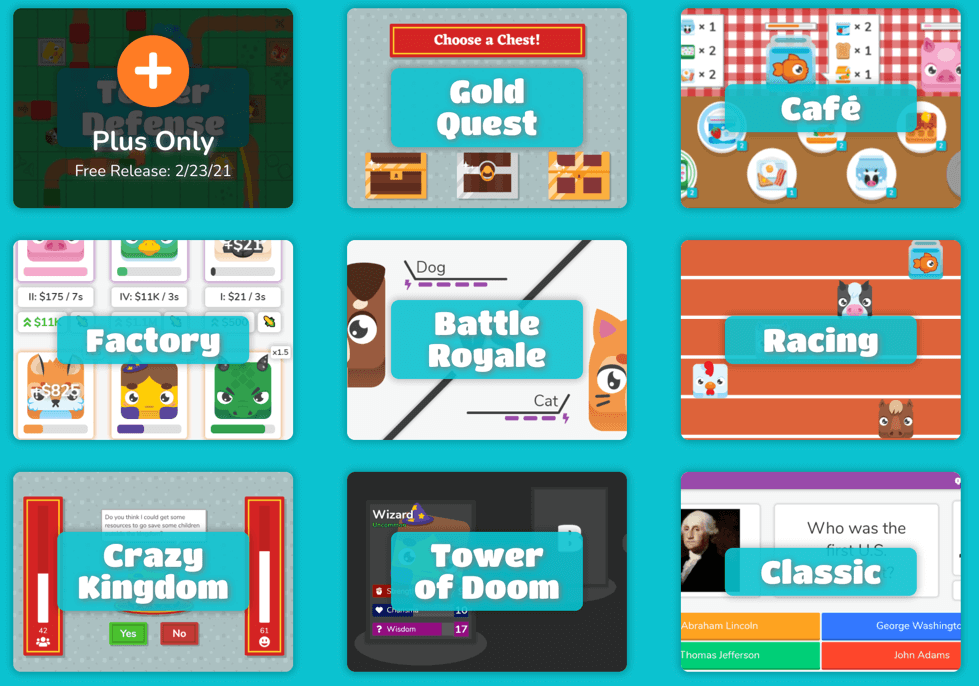
During a Blooket live game, students play on their own devices, either independently or in teams, while the teacher’s screen can show a leaderboard or progress. The questions and answers shuffle for each student, allowing self-paced answering. Faster students might answer more questions and thus gain more rewards, but even if someone is behind, a lucky break in the game (like finding a bonus chest) can catch them up, keeping hope (and excitement) alive.
Key Features:
- Unique Game Modes: A variety of playful modes like Tower Defense, Cafe, Racing, Battle Royale, etc., each providing a different gaming experience on top of the question set.
- Student Engagement: Features like leaderboards, power-ups, and timed challenges keep students motivated. For example, power-ups can multiply points or affect opponents, adding strategy to learning.
- Homework Assignments: Assign games for solo play; students can practice by playing a game on their own and you get the results once the assignment ends (great for remote learning or extra credit).
Pricing: Blooket’s Starter tier is free, allowing unlimited question sets and access to all core game modes, with games hosting up to 60 players at once. The paid Blooket Plus plan is about $2.99 per month (billed annually). There’s also a Plus Flex ($4.99 month-to-month) for those who want a shorter commitment.
5. Gimkit – Best for strategy-based quiz games with student collaboration
Great for: Middle and high school classes, especially for review sessions where you want students to think strategically (works in classrooms or remote).
Gimkit blends quiz review with real-time strategy in a way that feels fresh and addictive. At first glance, it looks like other quiz tools, like ClassPoint. But where Gimkit stands apart is how it turns that process into a full-on game economy.
In Gimkit, students answer questions on their own devices, but instead of a one-and-done approach, questions repeat in a loop, and each correct answer earns in-game money. Students can then use that virtual cash to “buy” power-ups during the game. This gamified economy hooks students in: they must decide whether to spend earnings on upgrades immediately or save up for bigger bonuses, introducing a layer of strategy and monetary system gameplay not found in other tools.

Key Features:
- Live Game & Team Modes: Play in real time, solo or in teams, with dynamic modes (Classic, Team Trust No One, etc.) that offer different objectives and twists.
- In-Game Currency & Power-ups: Students earn virtual money for each correct answer and spend it on power-ups (e.g. score multipliers, etc.), adding strategy to knowledge recall.
- Assignments (Homework Mode): Allows you to assign a Gimkit for individual practice – students play a game on their own until they reach a set dollar goal or time, perfect for homework or asynchronous learning.
- Customizable Kits: Easily create question sets (“kits”) or import from CSV/Quizlet. Supports adding images and audio to questions for richer content.
- Real-Time Feedback and Reports: See live progress during the game (who’s answering quickly or struggling) and get detailed post-game reports on accuracy and earnings per student.
Pricing: Gimkit offers a free basic version (“Gimkit Basic”) with unlimited games but a rotating selection of game modes (usually 3 at any given time) and some feature limits. To unlock all game modes and extra features, you’ll need Gimkit Pro, at $59.88 per year. There are also Group licenses for schools (e.g. $1,000/year for a whole school).
6. Duolingo – Best for gamified language learning for individuals
Great for: Casual learners of all ages (or students in language classes) who want to study a new language through bite-sized, game-like exercises on their phone or computer.
Duolingo is one of the most widely used language-learning tools in the world, and a big part of that success comes down to its smart use of gamification. Learning on Duolingo feels like playing a mobile game: lessons are short and animated, you earn points (XP) for completing them, maintain daily streaks for continuous practice, and collect badges/achievements for hitting milestones.
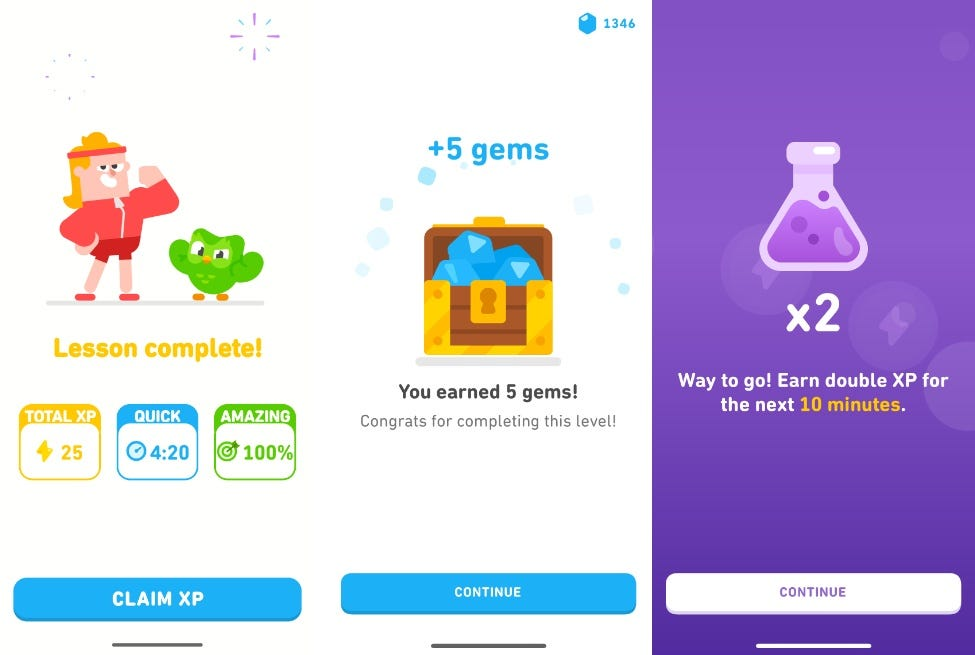
These elements tap into users’ completionist instincts to keep them coming back. For example, the streak counter motivates you not to skip a day of practice, and the app will even prompt you or offer a “streak freeze” item if you’re about to break it. Every lesson has a progress bar, and getting answers correct fills the bar. Make too many mistakes and you might “fail” the lesson and have to repeat, similar to losing a life in a game
Key Features:
- Streaks and XP: Earn experience points for each lesson; keep a daily streak going to earn rewards. These mechanics encourage regular practice and make learning addictive.
- Levels and Skill Trees: Language content is organized in a skill tree of units; as you complete lessons, you level up those skills (from Level 0 to Level 5) and unlock new content, akin to progressing through game levels.
- Leaderboards and Leagues: Users are placed in weekly leagues with around 30 others. By earning XP you climb the leaderboard; top performers get promoted to higher leagues, adding a friendly competitive drive.
- Badges and Achievements: Duolingo awards badges for goals like completing a certain number of lessons without error, or finishing a course “tree”.
- Adaptive, Gamified Lessons: Lessons involve translating phrases, typing what you hear, matching words, etc. Hints, immediate feedback, and a hearts/lives system (you can lose hearts for mistakes unless in practice mode) make it interactive. New features like monthly challenges, stories, and even a new music or math skill in the app keep the experience fresh.
Pricing:
Duolingo’s core content is free to use (supported by ads). The premium tier, Super Duolingo (formerly Duolingo Plus), costs about $6.99 per month. Super Duolingo removes ads, provides unlimited hearts (no interruption for mistakes), enables offline lessons, and includes a few extra perks like monthly streak repairs.
7. SC Training (formerly EdApp) – Best for mobile microlearning with gamified lessons
Great for: Corporate trainers and L&D professionals who need to deliver bite-sized training modules (especially on mobile devices) with gamification elements to boost completion and retention.
SC Training is a mobile-first microlearning platform that incorporates gamification to make corporate training more engaging. With SC Training, training content is broken into short, focused lessons that learners can complete on their smartphones in minutes. The platform offers a library of templated learning games and quizzes, which instructional designers can easily plug content into.

Another standout feature is SC Training’s focus on engagement through features like push notifications (nudging learners to complete their next “daily challenge”) and social learning (discussion and assignments).
Because SC Training lessons are meant to be fun and quick, employees are more likely to actually finish them, which is half the battle in corporate training. In short, SC Training leverages gamified microlearning to transform mandatory training into something more like a series of mini-app challenges.
Pricing: EdApp offers a generous free plan for small teams or individual instructors. For organizations needing advanced analytics, custom domains, or dedicated support, premium plans start around $2.95 per active user per month, with enterprise pricing available for large deployments.
8. ProProfs – Best for creating gamified quizzes and “brain games”
Great for: Teachers, trainers, or HR managers who want a straightforward way to create quizzes, puzzles, and knowledge games for learners, with an all-in-one tool (no coding required).
ProProfs is a flexible gamified learning platform built around quizzes, flashcards, and learning tools designed to be both simple and engaging.
ProProfs provides access to a library of “brain games”, like word searches, crossword puzzles, and jigsaw puzzles, which can be used to engage learners in different ways beyond standard Q&A. It might not have the flashy graphics of some K-12 apps like ClassPoint or Blooket, but it shines in flexibility. You can embed quizzes in websites, create custom certificates, and even make an entire mini-course with lessons followed by scored quizzes. The learning paths functionality lets you string together modules that unlock sequentially, which can feel like levels in a game.
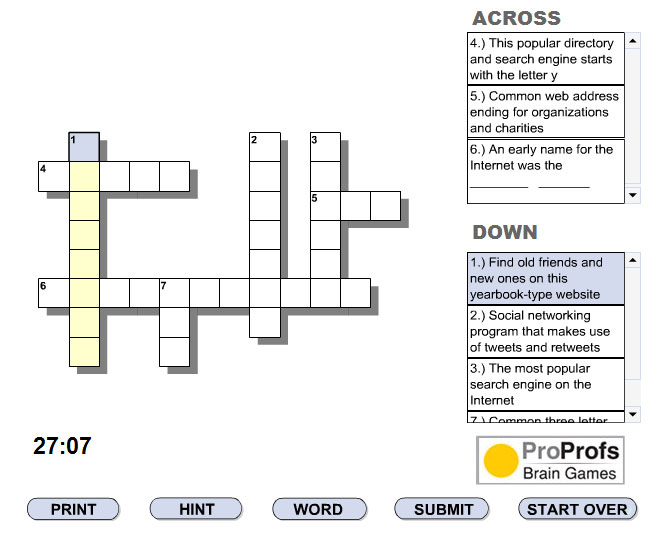
Key Features:
- Quiz and Exam Maker: Create quizzes with various question types (multiple-choice, fill-in-the-blank, true/false, etc.), add images/videos, and set scoring rules. Timers and instant feedback make the experience more game-like.
- Puzzle & Game Templates: Utilize pre-made brain games (crosswords, word scramble, etc.) and educational games to supplement learning and make it enjoyable.
- Certificates and Badges: Automatically award certificates for passing scores or badges for course completion, giving learners a sense of achievement.
- Learning Paths: Organize content into courses where learners “unlock” the next lesson or quiz after completing the previous one, simulating a level-up progression.
Pricing: ProProfs has a free basic version that allows a limited number of quizzes and responses. For expanded use, plans typically start around $20 per month for the Essentials plan. Higher-tier plans (around $50 to $200+ per month) add features like white-labeling, advanced reports, custom integrations, and more participants. They also offer enterprise solutions.
9. Mambo.IO – Best for customizable gamification in corporate training
Great for: Organizations that want to add a layer of gamification (points, badges, challenges) to existing training programs or business processes, with a flexible platform that can integrate with their systems.
Mambo.IO is an enterprise gamification platform that can be used to create gamified learning experiences or even gamify non-learning workflows.

In the context of training, Mambo allows companies to design custom gamification schemes. Because it’s a white-label platform, companies often integrate Mambo’s gamification engine into their own LMS or intranet. You can set up rules and challenges without coding, and Mambo will handle tracking those events and awarding the points/badges. It’s highly customizable in terms of look and feel and logic. This means it’s not a standalone flashy app, but rather a behind-the-scenes engine to gamify corporate learning.
Key Features:
- Custom Points & Badges System: Define custom point actions (e.g., points for finishing a lesson, points for high quiz scores) and design badges for achievements, tailoring the gamification to your objectives.
- Leaderboards and Levels: Set up leaderboards to spark competition among learners or teams. Implement level progressions so users unlock new levels/titles as they accumulate points.
- Challenges & Quests: Create challenges or quests (e.g., finish a series of modules by a deadline, or daily quiz challenges) with rewards for completion, encouraging consistent participation.
- Reward Store: Option to have a rewards catalog where learners can redeem their accumulated points for real or virtual rewards (swag, gift cards, etc.), adding tangible incentives.
- Integration Friendly: Robust API and integration options to plug into LMS, HR systems, or websites – so gamification can happen within the platforms employees already use, seamlessly.
Pricing: Mambo.IO typically offers enterprise pricing based on the scope of use (number of users, modules, etc.). There isn’t a public fixed price, as solutions are often tailored.
10. Centrical (formerly GamEffective) – Best for gamified corporate training and performance
Great for: Enterprise training and performance management, especially sales or customer service teams, where ongoing engagement, friendly competition, and real-time feedback can boost results.
Centrical is a corporate gamification platform that combines e-learning with continuous performance gamification. It transforms things like onboarding programs, sales targets, or customer service KPIs into interactive missions and games.
Centrical provides gamified narratives and competitions. It also features a virtual currency/store, where employees earn coins for learning activities and can spend them on perks or prizes, adding an extra layer of motivation.

Social learning and collaboration are part of Centrical’s approach too. Colleagues can see each other on leaderboards, share knowledge in challenges, and celebrate achievements (Centrical integrates recognition into the platform).
Key Features:
- Game Narratives: Turn training programs into story-based missions or themed competitions (for instance, a space adventure where each course is a “planet” to conquer, etc.), increasing immersion.
- Competitions & Leaderboards: Run team or individual competitions tied to learning goals or performance metrics, with real-time leaderboards to drive engagement and fun rivalry.
- Social & Collaborative Features: Integrate social learning by allowing peer shout-outs, knowledge challenges, or mentoring, all tracked and gamified. A built-in newsfeed or chat can keep the community feel.
- Analytics & Personalization: Robust analytics for managers to track progress. The system can personalize the next challenge or learning module for each user based on their progress, ensuring they are appropriately challenged and supported.
Pricing: Centrical is an enterprise solution and does not publicly list pricing. It typically operates on a software subscription model tailored to the organization’s size and needs (pricing available on request.
11. Docebo (LMS) – Best for an LMS with built-in gamification
Great for: Medium to large organizations that need a full-featured Learning Management System (LMS) for employee or customer training, with gamification features like points, badges, and competitions to drive learner engagement.
Docebo is a powerful LMS platform used by companies to manage and deliver e-learning, and it includes gamification tools out-of-the-box. In Docebo, administrators can configure a points system for various learner actions: completing a course might grant points, getting a high quiz score might grant more, contributing to discussion boards could also earn points, etc.
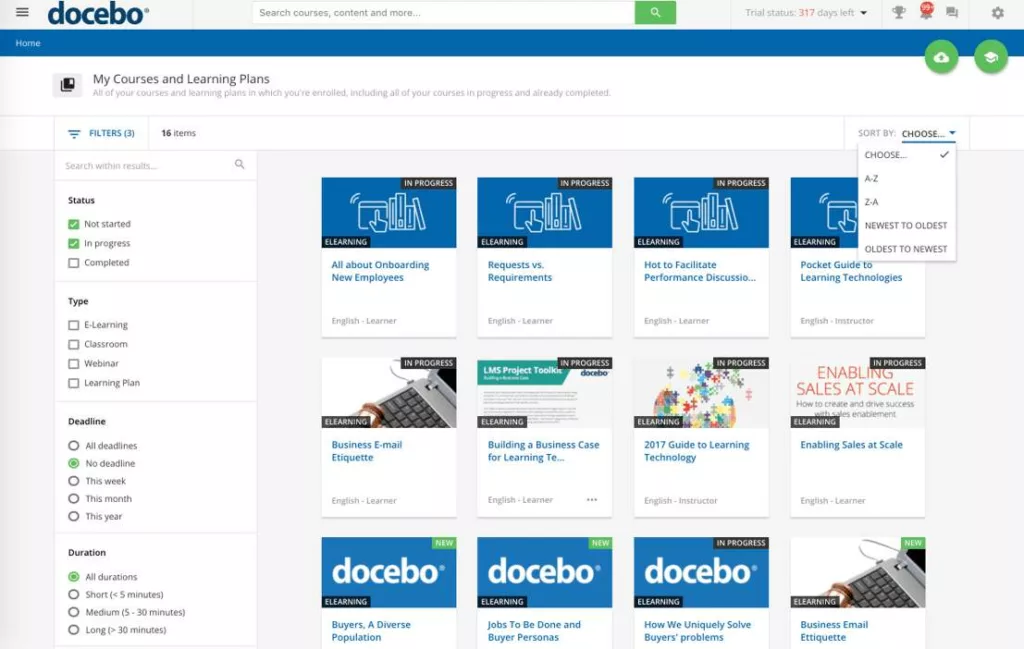
Additionally, Docebo has embraced social learning and AI. It has a “Coach & Share” module where learners can ask questions and earn points when they contribute answers or useful content. The platform’s use of AI can recommend content to users, creating a personalized learning path,and you could gamify that by awarding points when users complete the AI-suggested courses (encouraging them to follow recommendations).
Key Features:
- Points, Badges, Leaderboards: Fully configurable gamification system – assign points to learning activities, create badges for milestones, and display leaderboards at global or group level to inspire competition.
- Contests and Levels: Run time-bound contests or challenges (e.g., “Learner of the Month”) using points. Define levels (like Bronze, Silver, Gold learner) that users achieve as their point totals increase, providing a continual sense of progression.
- Reward Marketplace: Optionally integrate a reward system where learners can redeem points for rewards or perks (requires some setup, but possible within Docebo or via integration).
- AI-Powered Personalization: Docebo uses AI to recommend content; combined with gamification, it can guide learners to complete those items (for points) which aligns personal interest with rewards.
- Comprehensive LMS Features: Beyond gamification, Docebo offers robust course management, tracking, certifications, e-commerce, and more.
Pricing: Docebo is sold as an enterprise SaaS solution. It typically requires contacting their sales for a quote. Pricing is on request and depends on number of learners and modules you need.
12. Moodle with Gamification Plugins – Best for open-source flexibility in gamified learning
Great for: Schools, universities, or organizations that use Moodle (the open-source LMS) and want to add gamified features like points and badges, especially if they prefer self-hosting and customization.
Moodle itself is a widely-used open-source LMS that can be enhanced with various plugins to introduce gamification. Admins or teachers can set up badges that are aligned with the Open Badges standard, meaning they can be exported or shared externally, giving learners portable proof of their achievements.
Beyond badges, Moodle has optional plugins like Level Up! which introduces an RPG-like level and XP points system in any course. Another plugin is Quizventure, which turns quiz questions into a Space Invaders-style shooting game. There’s also Stash for virtual item collection and Game which turns quiz questions into games like hangman or snakes and ladders.

The strength of Moodle in gamification is flexibility. Since Moodle is free and open-source, these solutions can be very cost-effective, though they require some technical setup.
Key Features:
- Badges: Built-in support for awarding badges based on criteria (activity completion, grade achieved, etc.), with site-level and course-level badges available.
- Levels and Points (via Plugin): Add levels/XP to courses using plugins like Level Up!. Students get immediate visual feedback as they gain points for participating, encouraging them to explore more of the course to “level up.”
- Conditional Activities: Moodle allows setting conditions (e.g., must score X on Quiz 1 to unlock Quiz 2). This can be used to create quest-like progressions where completing tasks unlocks new “quests” or content, akin to game levels.
- Games and Activities Plugins: Use plugins such as Quizventure (arcade game quizzes), Hangman, Crossword, or Millionaire (Who Wants to Be a Millionaire-style quiz) to turn standard quiz questions into interactive mini-games for variety.
- Leaderboard (via Plugin): Some gamification plugins also provide a leaderboard block so students can see how they rank by points in the course, tapping into competitive motivation.
Pricing: The Moodle software is free (it’s open-source). However, if you self-host, you’ll need a server and technical know-how (or an IT team). MoodleCloud (the official hosted Moodle service) offers plans that start at around $120/year for small deployments.
FAQs
How do I know which gamified learning platform is right for me?
It depends on what you need. Are you teaching live in a classroom and want instant interaction? Or are you building self-paced modules for your team? Some platforms are better for quick quizzes and energy, others for deep tracking and long-term learning. Think about how much time you have to set things up, how tech-savvy your audience is, and whether you want more customization or something plug-and-play.
Are gamified learning platforms just for classrooms? Or can they work in corporate settings too?
They absolutely work beyond the classroom. In fact, many gamified learning platforms were built with adult learners and professional training in mind. Whether you’re onboarding new hires, running compliance sessions, or helping employees retain product knowledge, gamification can make those moments more engaging, and memorable.
Which gamified learning platform is best if I don’t have much time to set things up?
If simplicity matters most, go with something that’s easy to launch and doesn’t require hours of prep. For teachers, ClassPoint (as part of PowerPoint) and Blooket are great because they let you embed quizzes directly into lessons without extra apps. For trainers, EdApp and ProProfs offer ready-made templates so you can drop in content fast. These platforms keep setup minimal while still delivering solid engagement.
Can gamified learning platforms help with long-term retention?
Some definitely do. While many tools focus on live interaction and instant feedback, a few go further by reinforcing memory over time. Duolingo uses spaced repetition to help learners retain language skills. Edcafe AI adapts question difficulty based on design. And EdApp’s Brain Boost feature revisits past material to help users hold onto what they’ve learned. So yes, if you pick the right gamified learning platform, it can support both engagement and lasting knowledge.
How do I know if my team or students are actually benefiting from gamification?
Look at two things: participation and progress. If people are showing up, staying focused, and coming back without being reminded, that’s a sign gamification is working. But to go deeper, check the data. Most quality gamified learning platforms offer reports that show who’s completing what, how often, and how well they’re doing. That lets you see real trends instead of just guessing.
